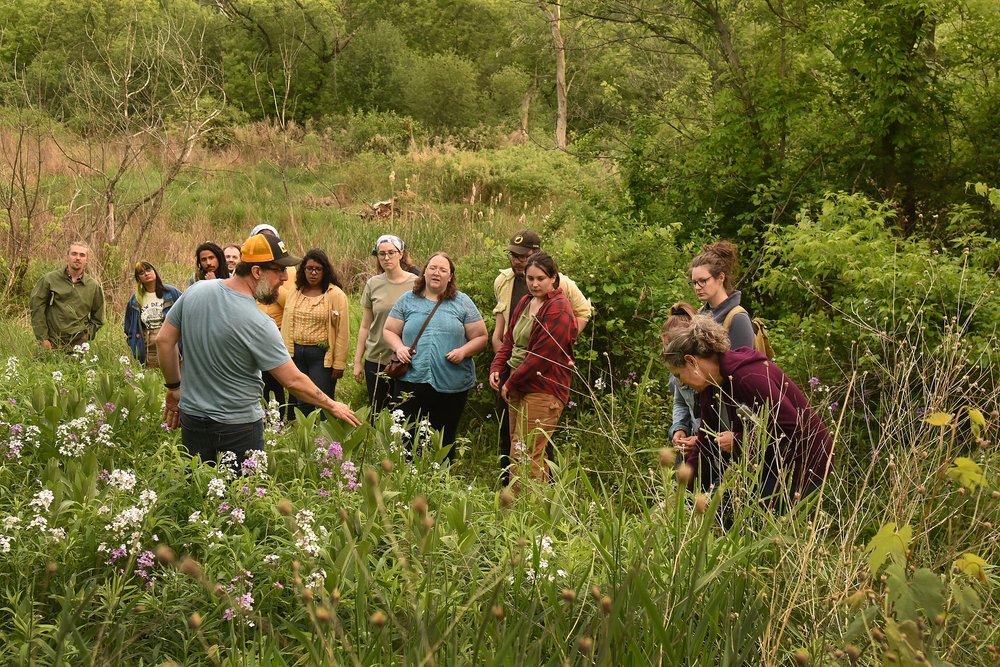Without foraging, none of us would be here. Before farming, our earliest ancestors relied on gathering berries, nuts, seeds, and vegetables to survive. Their diets were supplemented by meat, but research suggests that, for the most part, it was plant-based foods that kept many of them alive. In January 2024, for example, one study published in Plos One, analyzed the remains of 24 early humans in Peru and suggested that their diets were likely 80 percent plants and 20 percent meat.
Of course, diets varied from place to place. Those close to the coast likely ate more fish, for example, but overall, experts seem to agree that wild plants were crucial to early human survival. “Foraging is not at all a new activity,” says Sean Rowe, a foraging tour guide who is dedicated to educating people about the benefits of the ancient practice. “The human race has descended from foragers. It’s in the past of all people across the globe.”
Foraging isn’t a practice relegated to the history books. All over the world, in many Indigenous and rural communities, people still rely on foraged plants as a source of nutrition. In the West, industrialized farming is king, but foraging is making a comeback—particularly in the Michelin-rated dining scene. For example, last year, New York’s prestigious plant-based restaurant Eleven Michelin Park hosted a forager dinner made with local ingredients from the forests of Greater New York. In Wales, Green Michelin Star restaurant Annwn’s menu features everything from wild garlic “preserved in its life cycle” to chicken of the woods mushrooms to crab apple leaves.
 Annwn Restaurant
Annwn Restaurant
But foraging isn’t just for top chefs. Research shows that in recent years, more people have decided to take it up as a hobby, or are interested in doing so. In 2021, for example, one survey by the outdoor clothing brand TOG24 suggested that a quarter of Brits had foraged wild mushrooms in the past, and three-quarters were keen to forage more wild food. In the US, in 2020, foraging experts told Civil Eats that traffic to their sites and digital classes was booming as people sought out creative ways to get outside amid the pandemic.
Rowe believes that more people are taking up foraging to deal with the pressures of busy modern life. “I think the resurgence of the activity can partly be correlated with the movement to get in touch with one’s food source, the over-dependence on the modern food system, and the need to “unplug” from the veneer of social media,” he says. “Some of our technologies and modern conveniences tend to keep us fragmented from the rest of the natural world. Also, and this is a big one, because it feels good! That would be my speculation anyway.”
 Pexels
Pexels
BECOME A VEGNEWS VIP: Get exclusive product deals, freebies, and perks galore!
Indeed, research suggests that spending time in nature can have a big impact on our physical and mental health. It’s associated with a reduced risk of depression and anxiety, for example, and it may also improve cognitive function and support our immune systems, too.
Foraged plants themselves are also good for us. They are a source of nutrients and beneficial plant compounds, and they’re nearly always free of pesticides. “Also, because you are the one harvesting, you can be sure you are getting the absolute freshest food compared to what you would find in stores, where it would be quite difficult to know for certain how long that food has been sitting on a truck or on a shelf,” says Rowe.
There are plenty of health benefits associated with foraging, but it’s important to note that if you’re a beginner, it’s not advisable to just step outside and start eating the first berry you come across.
 Alicia Silverstone
Alicia Silverstone
In August, actor Alicia Silverstone set off alarm bells when she filmed herself eating a berry on a sidewalk in England. She initially thought it was a tomato, but it turned out to likely be a Jerusalem cherry, which can be toxic. Silverstone avoided harm because she didn’t swallow the berry, but it’s important to be careful when you’re putting anything in your mouth if you’re not 100 percent sure what it is.
5 tips for safe, ethical foraging
If you’re interested in learning more about foraging, below, we’ve gathered five top tips from Rowe to help get you started on your wild plant journey safely.
1 Don’t rely on instinct
A common thread of advice when you’re not sure what to do is to “trust your gut.” But to put it bluntly: don’t do this with foraging. “The brain is very good at fitting new info with our own biases,” says Rowe. “In other words, it’s quite tempting to make something fit even if you’re not 100 percent certain. And when it comes to eating plants and mushrooms, this could be quite risky.”
Often, many plants and mushrooms look almost identical, and this can pose a danger if you pick the version that is poisonous rather than its harmless doppelganger. You might end up with an upset stomach or a swollen tongue, warns Rowe. And in some circumstances, an error of judgment when foraging could even be fatal.
“A very common mushroom in my area called Destroying Angel in the Amanita group of fungi is a beautiful sight but also one of the most deadly if eaten. Harvesting this mushroom because it looks similar to a white button mushroom that you would purchase at the market would most likely be the last time you would ever eat that mushroom or anything else!” —Sean Rowe
2Do your research
The best way to keep yourself safe when foraging is to do your research in advance. “You need to arm yourself with excellent book sources from experts in the field,” advises Rowe. He notes that apps and online resources are helpful, but books are by far the most reliable sources of extensive foraging information.
He advises Samuel Thayer’s Field Guide to Wild Edible Plants, for example, which “is probably the most comprehensive guide on the subject ever written,” as well as Wild Edible Plants by John Kallas, and The Forager Chef’s Book of Flora by James Beard Award-winning chef Alan Bergo (who also runs the wild food website Forager Chef).
If you’re looking for an online resource, you can also check out Learn Your Land by Adam Haritan, and, of course, Rowe’s own website, Sean Rowe Rent-A-Forager. You can also find resources on social media. “I host a YouTube series called Can I Eat This? which combines foraging and music performance with a little humor,” says Rowe, who is also a singer-songwriter.
 Sean Rowe
Sean Rowe
3 If in doubt, ask for help
If you’re a foraging beginner, the safest way to start your wild food journey is by hiring a guide. Rowe runs his own foraging tours in New York, where he talks attendees through the historical uses of plants, their nutritional value, and which ones are poisonous look-a-likes.
You can search for foraging experts in your local area, too, just be careful to look for legitimate experts with extensive experience in the field. “Currently there is no path to certify and rigorously test foragers in this country to my knowledge,” says Rowe. “On top of that, anyone can create a website and spread whatever they want on social media so one needs to tread lightly in this terrain.”
“As many indigenous people know full well, by using plants we can treat the land like it is an extended garden that not only benefits us but can also be used as a tool to facilitate more viable habitats for other animals.”
4 Start with invasives
Foraging isn’t just about keeping yourself safe, it’s also about being respectful of the environment. Take care not to take an entire plant from its natural habitat, for example, as this can disrupt its ecosystem.
“Once you know a plant is good and edible then you should determine how the plant regenerates and depending on what part of the plant you are after, this will help you determine how much you should take,” says Rowe. “As a general rule, taking all of any plant is a bad thing unless you’re talking about plants that are incredibly invasive like garlic mustard or Japanese knotweed.”
If you’re concerned about overharvesting, it’s advisable to stick with invasive or abundant options, notes Rowe. Invasive plants are non-native species that spread rapidly and outcompete native plants in an ecosystem. Foraging them is a win-win, as it helps the environment, and many of them are delicious and easy to cook with.
“In my area, these would be Dame’s Rocket, Autumn Olive, White Mulberry, Mustard Greens, Japanese Knotweed, and Goutweed,” explains Rowe. “Other plants that are not invasive per say but are easily recognizable and usually abundant are Common Burdock, Oak acorns, Hickory nuts, Black Walnut. These are very much worth harvesting.”
However, if you’re foraging invasive plants, be careful not to spread the seed around, as this could “inadvertently help the plant further its mission,” warns Rowe.
 Pexels
Pexels
5 Be a good environmental steward
Foraging is a rewarding, beneficial practice, but it can also be dangerous and damaging if it’s not carried out properly. Many animals rely on fruits and berries to survive, so it’s important to be mindful of not accidentally pulling up an important food source.
“Key components of effective stewardship include knowing what each plant species needs to thrive, what its life cycle is, and whether it is native to your environment or is potentially harmful in the way that it spreads and chokes out other species,” says Rowe. “You should also know if the plant is not only rare in general and what its local or regional distribution is. You can also ask the question as to what animals depend on this particular plant for food and how it fits into the local ecosystem.”
“There’s a lot to think about here and a lot of nuance,” he adds. “Educating yourself is the key.”
For more plant-based stories like this, read:
JUMP TO ... Latest News | Recipes | Guides | Health | Shop
Here at VegNews, we live and breathe the plant-based lifestyle, and only recommend products we feel make our lives amazing. Occasionally, articles may include shopping links where we might earn a small commission, but in no way does this effect the editorial integrity of VegNews.



.jpg?sha=2f0641838b14e9d8)





